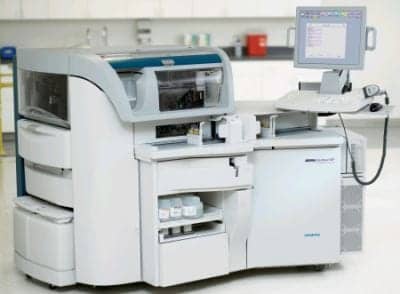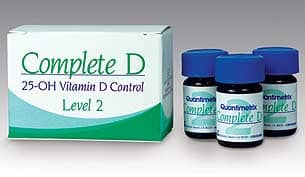
Connie Mardis, MEd
Vitamin D, a fat-soluble hormone known as the “sunshine vitamin,” has a well-established role in absorption of dietary calcium and phosphorus, and in bone health.1 Vitamin D testing volumes continue to increase as researchers study links between vitamin D and heart disease, diabetes, rheumatoid arthritis, multiple sclerosis, Parkinson’s disease, and some cancers.2 Laboratories can now meet the demands of increasing vitamin D testing volumes with an assay on a routine analyzer that detects approximately equimolar 25 (OH) vitamin D2and 25 (OH) vitamin D3 to provide accurate clinical assessment of deficiency, sufficiency, and toxicity.
ASSESSING RISK
Without sufficient vitamin D, bones can become thin, brittle, or misshapen. Rickets and osteomalacia lead to bone softening and are the classic vitamin D deficiency diseases. Together with calcium, vitamin D helps protect older adults from osteoporosis. Vitamin D has other roles in the body, including modulation of cell growth, neuromuscular and immune function, and reduction of inflammation.3,4,5
Despite the fact that cow’s milk in the United States has been fortified with vitamin D since 1932, vitamin D deficiency rates are increasing.1,19 Vitamin D is naturally present in very few foods.6 There are small amounts in meat, eggs, and fish, particularly salmon and mackerel. The major source of vitamin D comes from production within the body. When ultraviolet rays from sunlight strike skin unprotected by clothing or sunblock, vitamin D synthesis is triggered.
It has been suggested by some vitamin D researchers that approximately 5 to 30 minutes of sun exposure between 10 am and 3 pm at least twice a week to the face, arms, legs, or back without sunscreen can lead to sufficient vitamin D synthesis.6 Yet in the United States, it is estimated that 77% of adults are insufficient or deficient.1 More than one billion people are vitamin D-deficient worldwide.1
Many experts support a total 25 (OH) vitamin D level of >30 ng/mL as sufficient, levels of 20 to 30 ng/mL as insufficient, and levels of <20 ng/mL as deficient.1,12,23,24 As yet, there is no consensus document establishing cut points of normal and abnormal value ranges for 25(OH) vitamin D. Population reference values cannot be used for vitamin D because many individuals have inadequate (insufficient or deficient) levels.1,7
Some people with mild to moderate deficiency in vitamin D may have no symptoms at all, or just vague aches and pains. With a severe deficiency, muscles can be weak, making it difficult to rise easily from a seated position; bones may ache and be tender to the touch.2 Older people may be more prone to falls or fractures.2
Vitamin D deficiency is more common in winter and in people who are obese and physically inactive.2 Other groups that are at higher risk for inadequate levels include dark-skinned individuals, individuals with limited sun exposure, and breast-feeding infants.1 Women are also more likely to be lacking in vitamin D than men.2

Siemens’ ADVIA Centaur® XP Immunoassay System has a comprehensive menu of more than 65 assays, including Vitamin D Total, with a Time-To-First-Result (TTFR) of 18 minutes and throughput of 240 tests/hour. It easily connects to scalable standalone or track-based automation solutions.
A study in the Medical Journal of Australia found that women with gestational diabetes also commonly have inadequate vitamin D levels. A woman’s vitamin D levels when pregnant can have long-term consequences for the bone health of her children. In addition to impacting bone density and calcium status, vitamin D deficiency is linked to softening of the skull bones in newborns, prematurity, schizophrenia, and childhood respiratory infections and type 1 diabetes.2
A Finnish study (10,366 children) showed that infants who had received 2,000 IU/day of vitamin D3 during their first year of life were 80% less likely to develop type 1 diabetes. Children who were deficient had a 200% increased risk of type 1 diabetes.8
Also at higher risk of vitamin D deficiency are those who:
- Are elderly and/or housebound2;
- Have cognitive impairment2;
- Have gastrointestinal disease2;
- Take certain medications (ie, antiepileptic agents phenobarbital, and phenytoin)2;
- Are shift-workers2;
- Have had gastric bypass17,18; or
- Cover their bodies extensively for cultural, lifestyle, or heath (ie, sun protection) reasons.2
As deficiency rates increase1,19—and support continues to build for vitamin D sufficiency as a general health indicator—so too has the demand for vitamin D testing.
ACCURATE ASSESSMENT OF TOTAL VITAMIN D
The rise in vitamin D testing volumes may increase the need for reliable testing solutions that deliver rapid turnaround times and improved workflow. Equimolar measurement of total 25(OH) vitamin D—the sum of 25(OH) vitamin D2and 25(OH) vitamin D3—is needed to provide accurate assessment of vitamin D status.12,15,21
Serum concentration of 25(OH) vitamin D is the best indicator of vitamin D status.6 It reflects vitamin D synthesized through unprotected skin or ingested in food or supplements and absorbed by the intestines. It has a half-life of 15 days.10 Vitamin D obtained from sun exposure, food, and over-the-counter or prescription supplements is biologically inert and must undergo hydroxylation in the liver and kidney for activation.3
Quantimetrix Introduces Complete D Vitamin D Control
Quantimetrix, Redondo Beach, Calif, has just released Complete D 25-OH Vitamin D Control—an FDA cleared, ready-to-use liquid control.
Developed and manufactured by Quantimetrix, the control is formulated with real human serum containing 25-OH vitamin D2and D3. It has a 2-year refrigerated shelf life from the date of manufacture, and 1-year open vial stability when stored at 2° to 8°C or 30 days at room temperature.
Values are traceable to the NIST standard SRM 972. Data is provided for LC-MS-MS, Diasorin Liaison, IDS-Direct EIA, IDS-RIA, and LC-MS-MS isotope dilution methods. Packaged in two levels, 3×3 mL per box.
(800) 624-8380; www.quantimetrix.com

There are two major types of vitamin D3:
- vitamin D2(ergocalciferol)—synthesized by plants, not produced by the human body and
- vitamin D3 (cholecalciferol)—made in large quantities in the skin when sunlight strikes bare skin. It can also be ingested from animal sources.
Most people meet at least some of their vitamin D needs through exposure to sunlight.1,6 Ultraviolet (UV) B radiation with a wavelength of 290 to 320 nanometers penetrates uncovered skin and converts cutaneous 7-dehydrocholesterol to previtamin D3, which in turn becomes vitamin D3.6 Season, time of day, length of day, cloud cover, smog, skin melanin content, and sunscreen are among the factors that affect UV radiation exposure and vitamin D synthesis.3 Excessive sun exposure does not result in vitamin D toxicity because the sustained heat on the skin is thought to photodegrade previtamin D3 and vitamin D3 as it is formed.1
Vitamin D assays measure metabolites of vitamin D2 and vitamin D3: 25(OH) vitamin D2and 25(OH) vitamin D3.21,22 There are other metabolites of vitamin D. However, it is the sum of 25(OH) vitamin D2and 25(OH) vitamin D3 levels (total vitamin D) that most reliably reflects a patient’s vitamin D status.7 A 2010 consensus panel recommends only measuring the total vitamin D value.16
If the assay does not detect vitamin D2 fully or even partially, it is likely that the patient’s result will be reported in the insufficient range when the actual circulating concentration is sufficient. At the opposite end of the spectrum, a serum 25(OH) vitamin D level consistently greater than 150 ng/mL is potentially toxic.1
Vitamin D toxicity can cause nonspecific symptoms such as anorexia, weight loss, polyuria, and heart arrhythmias.6 More seriously, it can also raise blood levels of calcium, which leads to vascular and tissue calcification, with subsequent damage to the heart, blood vessels, and kidneys.3
ADVANCES IN VITAMIN D TESTING
Vitamin D is not found free in the circulation. Extremely hydrophobic, vitamin D is bound either to vitamin D-binding protein or albumin. Consequently, it is challenging to measure vitamin D accurately and precisely.
Manufacturers have recognized the need to provide assays that yield a “total” vitamin D result in serum or plasma by recognizing both of the metabolites that are the most reliable indicators of vitamin D status: 25(OH) vitamin D2and 25(OH) vitamin D3. Some immunoassays detect only a portion of the vitamin D2component.13 The ideal assay measures 100% of both 25(OH) vitamin D2and D3.16
ADDITIONAL RESOURCES FOR
VITAMIN D TESTING
Abbott: www.abbott.us
DiaSorin Inc: www.diasorin.com
Diazyme: www.diazyme.com
Fujirebio: www.fdi.com
Gold Standard Diagnostics: www.gsdx.us
Immunodiagnostic Systems: us.idsplc.com/en-us/home
Ortho Clinical Diagnostics: www.orthoclinical.com
Randox: www.randox.com
UTAK Laboratories Inc: www.utak.com
Until there is an internationally recognized reference material available for manufacturers and methods to use to align their standardization, differences may be observed between manufacturers and laboratory-derived methods. Recently, the NIH Office of Dietary Supplements initiated the Vitamin D Standardization Program (VDSP) to make the measurement of serum 25(OH) vitamin D accurate and comparable over time, location, and laboratory procedure.
Direct detection methods for vitamin D are LC-MS/MS (liquid chromatography tandem mass spectrometry) and HPLC (high performance liquid chromatography). HPLC followed by UV detection is a highly repeatable method, and LC/MS/MS is a very accurate method when performed correctly.14,15 In newborns, LC/MS/MS results can be difficult to interpret because the assay is unable to distinguish the inactive 3-epi-25(OH) vitamin D3 from 25(OH) vitamin D3,14,15 unless modified to allow detection.20 Both HPLC and LC/MS/MS detect and measure 25(OH) vitamin D2 and 25(OH) vitamin D3 separately; what is needed to assess vitamin D status, however, is the sum of these values.16
Antibody-based methods currently available include manual and automated immunoassays. In the absence of an internationally recognized standard, some vitamin D assays are traceable to LC-MS/MS. Instrument options include benchtop analyzers, and now random-access immunoanalyzers with a full menu of routine and esoteric tests. Automated assays on high-throughput analyzers are typically the best choice for many laboratories due to workflow consolidations and efficiencies.
Automated immunoassays have a much faster turnaround time than manual immunoassays, radioimmunoassays, and the direct detection methods HPLC and LC/MS/MS.21
Vitamin D testing volumes continue to grow, making vitamin D one of the most commonly requested assays.12 The Vitamin D External Quality Assessment Scheme (DEQAS) has observed this dramatic increase in the increased enrollment in proficiency testing. In 2004, there were 141 participating laboratories. In 2009, the number of participating laboratories increased to 670 in 35 countries.9 This increase in participating laboratories is reflective of the increase of 25(OH) vitamin D testing. A study found that more than 50% of laboratories had experienced a 50% or more increase in vitamin D testing within a year.12 Scalable automation solutions are now available to consolidate testing platforms and accommodate growing vitamin D test volumes.
Challenges of precision, equimolarity, and automation on a routine analyzer have been addressed with tests introduced to the market in 2011. Siemens Healthcare Diagnostics introduced the ADVIA Centaur® Vitamin D Total Assay, a total 25(OH) vitamin D assay available on the ADVIA Centaur and ADVIA Centaur XP systems. This new vitamin D total assay has proprietary monoclonal antibodies, is equimolar, and is traceable to LC-MS/MS.
An assay utilizing monoclonal antibodies is most likely to have lot-to-lot and system-to-system consistency. The ADVIA Centaur Vitamin D Total Assay has minimal cross-reactivity for key interferents: for vitamin D2, 0.5%; for vitamin D3, 0.3%; and for 3-epi-25(OH) vitamin D3, 1.1%. The limit of detection (LoD) of the assay is 3.20 ng/mL, the limit of quantitation (LoQ) is 3.52 ng/mL, and the assay range is 3.7 to 150 ng/mL. The required sample volume for a single determination is 20 µL.
An equimolar vitamin D assay that fully measures 25 (OH) vitamin D2and 25 (OH) vitamin D3, is standardized to the VDSP, and has acceptable precision will provide results that allow clinicians to distinguish between patients who have deficiency, insufficiency, and sufficiency. A reliable vitamin D assay on a fully automated, random-access, routine analyzer that easily connects to scalable automation solutions can help laboratories consolidate platforms and maximize workflow efficiency.
Connie Mardis, MEd, is a contributing writer for CLP. For more information, contact Editor Judy O’Rourke, .
REFERENCES
- Holick MF. Vitamin D deficiency. N Engl J Med. 2007;357(3):266-81.
- Wilson P. Vitamin D: how do you know if you’re getting enough? The Pulse, ABC Health and Wellbeing Mar 4 2012, accessed at www.abc.net.au/health/thepulse/stories/2012/04/03/3459266.htm.
- Institute of Medicine, Food and Nutrition Board. Dietary Reference Intakes for Calcium and Vitamin D. Washington, DC: National Academy Press, 2010.
- Holick MF. Vitamin D. In: Shils ME, Shike M, Ross AC, Caballero B, Cousins RJ, eds. Modern Nutrition in Health and Disease, 10th ed. Philadelphia: Lippincott Williams & Wilkins, 2006.
- Norman AW, Henry HH. Vitamin D. In: Bowman BA, Russell RM, eds. Present Knowledge in Nutrition, 9th ed. Washington DC: ILSI Press, 2006.
- Dietary Supplement Fact Sheet: Vitamin D. National Institutes of Health June 24 2011 Available at: ods.od.nih.gov/factsheets/list-all/VitaminD/. Accessed May 15, 2012.
- Lai JK, Lucas RM, Clements MS, Harrison SL, Banks E. Assessing vitamin D status: pitfalls for the unwary. Mol Nutr Food Res. 2010;54(8):1062-1071.
- Hypponen E et al. Intake of vitamin D and risk of type 1 diabetes: a birth-cohort study. Lancet. 2001;358(9292):1500-1503.
- Carter GD, Berry JL, Gunter E, et al. Proficiency testing of 25-hydroxyvitamin D (25-OHD) assays. J Steroid Biochem Mol Biol. 2010;121(1-2):176-179.
- Jones G. Pharmacokinetics of vitamin D toxicity. Am J Clin Nutr. 2008;88:582S-6S.
- Carter GD, Berry JL, Gunter E, et al. Proficiency testing of 25-hydroxyvitamin D (25-OHD) assays. J Steroid Biochem Mol Biol. 2010;121(1-2):176-179.
- Rollins G. Vitamin D testing—what’s the right answer? Labs grapple with confusing analytics, evidence. Clin Lab News. 2009;35(7):1-9.
- Phinney KW. Development of a standard reference material for vitamin D in serum. Am J Clin Nutr. 2008;88(2):511S-2S.
- Hollis BW, Horst RL. The assessment of circulating 25(OH)D and 1,25(OH)2D: where we are and where we are going. J Steroid Biochem Mol Biol. 2007;103(3-5):473-476.
- Hollis BW. Measuring 25-hydroxyvitamin D in a clinical environment: challenges and needs. Am J Clin Nutr. 2008;88(2):507S-10S.
- Souberbielle JC, Body JJ, Lappe JM, et al. Vitamin D and musculoskeletal health, cardiovascular disease, autoimmunity and cancer: Recommendations for clinical practice. Autoimmun Rev. 2010;9(11):709-715.
- Malone M. Recommended nutritional supplements for bariatric surgery patients. Ann Pharmacother. 2008;42:1851-1858.
- Compher CW, Badellino KO, Boullata JI. Vitamin D and the bariatric surgical patient: a review. Obes Surg. 2008;18:220-224.
- International Osteoporosis Foundation. Vitamin D deficiency is widespread and on the increase. ScienceDaily. 30 Jun 2009. Web 12 Apr 2012.
- Singh RJ, Taylor RL, Reddy GS, Grebe SK. C-3 Epimers can account for a significant proportion of total circulating 25-Hydroxyvitamin D in infants, complicating accurate measurement and interpretation of Vitamin D status. J Clin Endocrin Metab. 2006;91(8):3055–3061 © 2006 by The Endocrine Society doi: 10.1210/jc.2006-0710.
- Wallace AM, Gibson S, de la Hunty A, Lamberg-Allardt C, Ashwell M. Measurement of 25-hydroxyvitamin D in the clinical laboratory: current procedures, performance characteristics and limitations. Steroids. 2010;75(7):477-488.
- Lips P. Vitamin D physiology. Prog Biophys Mol Biol. 2006;92(1):4-8.
- Bischoff-Ferrari HA, Giovannucci E, Willett WC, Dietrich T, Dawson-Hughes B. Estimation of optimal serum concentrations of 25-hydroxyvitamin D for multiple health outcomes. Am J Clin Nutr. 2006;84:18-28.


